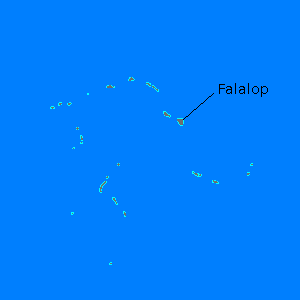![]() The Pacific War Online Encyclopedia
The Pacific War Online Encyclopedia
|
| Previous: Ulan Ude | Table of Contents | Next: Umezu Yoshijiro |
 |
"Murderer's Row" at Ulithi National Archives #80-G-2394131 |
(139.79E
10.015N) A large atoll
at the
western end of the Carolines,
some 370 miles (600 km) northeast of the Palaus and a like distance southwest of Guam, Ulithi has a large anchorage,
capable
accomodating 700 ships. This is sheltered by a substantial ring of
islets some 22 miles (35 km) long and 14 miles (23 km) wide. Nearby
Ngulu could anchor another 300 ships. The climate is hot and humid with
substantial rainfall, typical of the Caroline Islands.
The atoll was
discovered by Europeans in 1526 and left undisturbed until 1731, when
the native Micronesians
drove off Spanish missionaries. The culture featured an elaborate
tribal organization built around large communal houses build of
driftwood and thatch. The Japanese
had a weather and radio station
here, and begun an airfield and seaplane base on Falalop, but these were abandoned by late 1944 and most of the natives
evacuated to Yap.
Nimitz,
who loved to peruse
maps, noticed the atoll, realized its strategic potential, and arranged
for it
to be seized on 23 September 1944, during the Palaus
campaign. At this point there was still unwarranted optimism about
progress on Peleliu, and 323 Regimental
Combat Team from 81 Division
was detailed for the occupation. Cover was provided by Blandy's task group. There was no
resistance, and unloading was completed in two days. A battalion of Seabees followed, and Ulithi became
the forward fleet base
for the remainder
of the war. A 1200' (370 m) airstrip
was constructed on Falalop islet and a hospital and fleet recreation
center establish on other larger islets.
Because the base was not seen as permanent, no oil tank farm was constructed. Instead, the Navy maintained six to eight obsolete tankers at the anchorage, each with a capacity of 60,000 to 80,000 barrels (8000 to 11,000 tons) to serve as a floating tank farm. A fleet of 40 tankers shuttled the oil from Ulithi to the fighting fleet.
The base was attacked on 11 March 1945 by 24 P1Y "Frances" kamikaze aircraft guided close to their targets by four flying boats (Tan 2). Eleven
of the bombers were forced back to base by mechanical problems, and the remainder encountered miserable weather that forced course changes that depleted their fuel suppy. Four of the bombers diverted to Yap
as their fuel ran low, and seven more bombers ran out of fuel and
ditched at sea. The two remaining bombers arrived at Ulithi well after
nightfall. However, they were aided in
their attack by the failure of the base to black out all its lights,
and carrier Randolph took a damaging hit that inflicted casualties
of 25 dead and 106 wounded. The other bomber crashed into an
illuminated baseball diamond. For once, the Japanese underestimated the
success of the raid, since a C6N "Myrt" saw no carriers with visible damage the next day. Randolph suffered sufficiently light structural damage that she could be repaired at Ulithi in less than a month.
References
Inoguchi, Nakajima, and Pineau (1958)
The Pacific War Online Encyclopedia © 2007, 2009-2013 by Kent G. Budge. Index